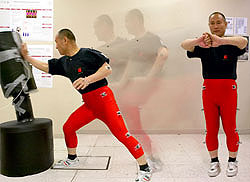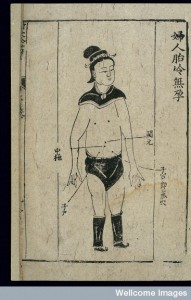I  recently did a short Q&A on the Radio 4 programme You & Yours on the subject of acupuncture and infertility. Here is some information on the current situation regarding evidence that I hope is helpful for prospective patients:
recently did a short Q&A on the Radio 4 programme You & Yours on the subject of acupuncture and infertility. Here is some information on the current situation regarding evidence that I hope is helpful for prospective patients:
Q: Is there any evidence that acupuncture improves fertility?
Yes, there is a whole raft of physiological research that goes some way to explaining the mechanisms that account for the positive results that acupuncturists and patients are seeing in clinics across the world. For instance, it is fairly well studied that:
- Acupuncture affects the hypothalamus and the pituitary – the overall controllers of the hormonal system – and therefore beneficially influences the reproductive organs, menstruation, ovulation and fertility;
- Acupuncture stimulates blood flow to the uterus by inhibiting the sympathetic nervous system (which is why it is so effective in helping implantation during orthodox fertility treatment);
- Acupuncture treatment ‘short-circuits’ the stress response that is so common in patients experiencing infertility, and that causes such hormonal chaos in their bodies. This explains why the great majority of women suffering from infertility who come for acupuncture report feeling much better in themselves, as well as noticing improvements in their menstrual function.
There is also plenty of other ‘low-level’ research evidence that supports this physiological ‘mechanism’ research: cohort studies, observational studies, case series and case studies, and practitioners’ own clinical audits, not to mention a couple of thousand years of grassroots clinical knowledge from Chinese medicine doctors. This evidence is supported by the fact that, on the ground, patients are voting with their feet, showing that acupuncture is a viable option to treat fertility.
In terms of ‘high level’ natural (i.e. non-IVF) conception evidence, the evidence is too limited and poorly conducted to come to firm conclusions. But lack of evidence is not evidence of non-effectiveness. The reasons for this lack of evidence are complex, but the limited finances of the acupuncture profession play a big part. Research costs money, and we simply don’t have the money that Big Pharma has to set up trials. In addition, there are methodological problems with the existing research, where acupuncture is typically compared to ‘sham acupuncture’ (in which needles are inserted into ‘non-acupuncture points’). But sham acupuncture does not constitute an inert treatment – it has physiological effects in itself – and effectively constitutes a mild dose of acupuncture. Because of this, ‘true’ acupuncture often comes out of the research as being only slightly more effective than sham, which leads some to incorrectly conclude that ‘it doesn’t work’. In fact, not only does acupuncture work better than having no treatment, even mediocre acupuncture (i.e. sham) works. To establish statistical significance using this methodology requires very large numbers of patients, much bigger than anything done to date.
When considering acupuncture treatment, patients should remember the potential downsides to orthodox fertility treatment, including higher numbers of birth defects and as-yet-unstudied effects of the drug treatments on women undergoing treatment. Acupuncture is very safe and leads to fewer side effects than drug treatments and of course can be given safely alongside orthodox treatment. It is also usually a much more cost-effective option. British Acupuncture Council members are trained professionals who know and understand the limits of their scope of practice, and routinely work alongside orthodox fertility consultants to provide patients with the best possible package of care.
So, we essentially have two legs of the stool – the clinical practice and the mechanisms – and we are looking forward to working with researchers to get the third leg – high quality trials with appropriate acupuncture and controls. Although there is insufficient evidence, we should proceed with what evidence there is. Given the patient demand, and the overall evidence picture, it makes no sense to say that acupuncture should not be available; indeed, it could be seen as unethical not to offer access to treatment that works for many women. Whatever the exact figures, it is indisputable that:
- Most women having acupuncture for fertility feel much better for it
- Many get improvements in their reproductive function and menstrual cycle
- Many get pregnant
 Q: Does acupuncture improves success rates with IVF?
Q: Does acupuncture improves success rates with IVF?
There is plenty of evidence of this – more than 50 randomised controlled trials and many reviews to aggregate and summarise them. However, whilst many are positive, some show conflicting results. Ultimately it tends to come down to how you crunch the data – which studies ar included and how they are interpreted. As explained above, acupuncture tends to be found effective when compared to having no treatment, but tends more to non-significance compared to sham controls. It is also worth pointing out that the type of acupuncture studied in the IVF trials tends to be far removed from good/usual clinical acupuncture practice, and therefore it is hard to reach conclusions and recommendations from it that relate to acupuncture as provided by British Acupuncture Council members.



 recently did a short Q&A on the Radio 4 programme You & Yours on the subject of acupuncture and infertility. Here is some information on the current situation regarding evidence that I hope is helpful for prospective patients:
recently did a short Q&A on the Radio 4 programme You & Yours on the subject of acupuncture and infertility. Here is some information on the current situation regarding evidence that I hope is helpful for prospective patients: Q: Does acupuncture improves success rates with IVF?
Q: Does acupuncture improves success rates with IVF?


